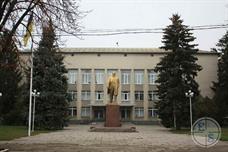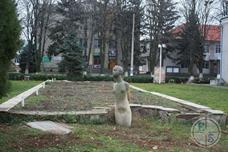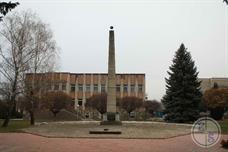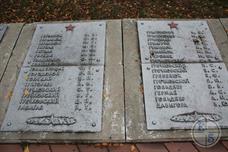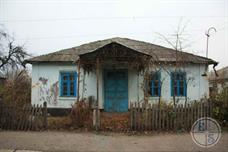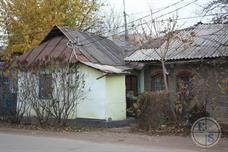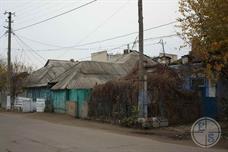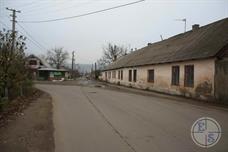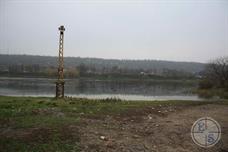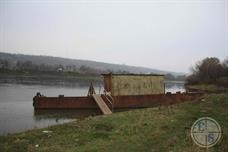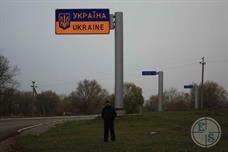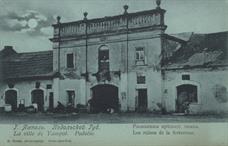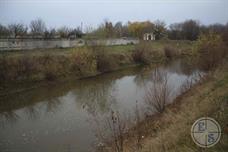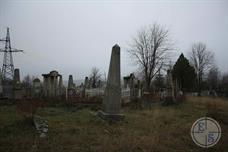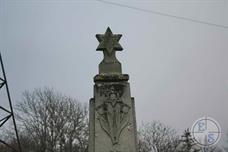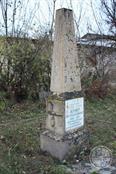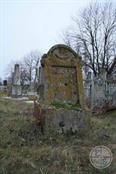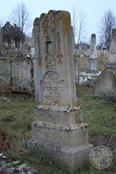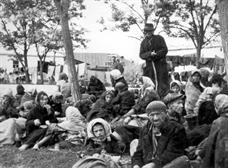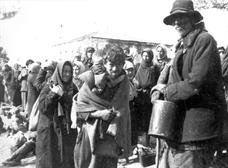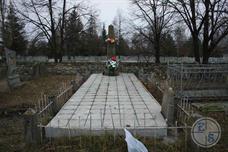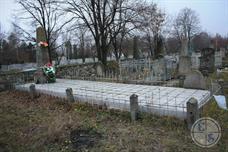Yampol
Yampol, 2012
Vinnitsa Region
In the XVI century Yampol was one of the major trading cities Bratslav, where the Dniester transported goods Black Sea, and in the opposite direction of the export of grain. The city was also known as a center kamenotёsnogo craft.
At the end of the XVI century Yampol with the villages nearest to it was acquired "great crown hetman" and the Polish chancellor Jan Zamoyski. The new owner has strengthened the city and rebuilt the castle. Perhaps it was in this period Yampol, as in other cities belonging to the Zamoyski, settled Jews.
At the end of the XVIII century. Yampol owned a well-known at the time the entrepreneur Potocki, to build a river port with warehouses and dock designed for the grain trade with Bender and Akkerman.
With the accession in 1795 to the Russian town Yampol was the county town Bratslav governorship.
In 1796, the county offices were moved from Yampol to the neighboring, larger town then, Tsekinovka. But because of the strong spill the Dniester River, inundating Tsekinovku, the center of the county was returned to Yampol, and confirmed that the royal decree in 1804
At the end of the XVI century Yampol with the villages nearest to it was acquired "great crown hetman" and the Polish chancellor Jan Zamoyski. The new owner has strengthened the city and rebuilt the castle. Perhaps it was in this period Yampol, as in other cities belonging to the Zamoyski, settled Jews.
At the end of the XVIII century. Yampol owned a well-known at the time the entrepreneur Potocki, to build a river port with warehouses and dock designed for the grain trade with Bender and Akkerman.
With the accession in 1795 to the Russian town Yampol was the county town Bratslav governorship.
In 1796, the county offices were moved from Yampol to the neighboring, larger town then, Tsekinovka. But because of the strong spill the Dniester River, inundating Tsekinovku, the center of the county was returned to Yampol, and confirmed that the royal decree in 1804
According to the contract Zborov 1649 Transnistrian border Yampol turned hundreds of cities Bratslav regiment in whose territory under the contract are not allowed to stay Jewish.
In 1784 104 Jews live in 24 houses, they were attributed to the community Shargorod. According to the census of 1787 Yampol already existed an independent congregation numbering 307 people (including Jews suburbs and nearby villages).
In the 1795- 1806 biennium. Christians belonged to from 177 to 238 houses, Jews - from 78 to 120 (26 - 38% of all homes).
Leaders of the Jewish community of about 15 families were large tenants, the landlord belonged to pay off items of income of a lump sum amount paid.
In 1827, there were three Yampol guild merchant, all of them - the Jews. Most of the Jews at that time were engaged in petty trade and crafts, service marina and viticulture.
In 1852, among 79 Yampolsky artisans were 66 Jews. According to the 1855 county Yampol and merchants were not the first and second guild, the guild and the third was 347 Jews and Christians 9, the number of heads of families bourgeois class - respectively 448 and 921 people.
In 1784 104 Jews live in 24 houses, they were attributed to the community Shargorod. According to the census of 1787 Yampol already existed an independent congregation numbering 307 people (including Jews suburbs and nearby villages).
In the 1795- 1806 biennium. Christians belonged to from 177 to 238 houses, Jews - from 78 to 120 (26 - 38% of all homes).
Leaders of the Jewish community of about 15 families were large tenants, the landlord belonged to pay off items of income of a lump sum amount paid.
In 1827, there were three Yampol guild merchant, all of them - the Jews. Most of the Jews at that time were engaged in petty trade and crafts, service marina and viticulture.
In 1852, among 79 Yampolsky artisans were 66 Jews. According to the 1855 county Yampol and merchants were not the first and second guild, the guild and the third was 347 Jews and Christians 9, the number of heads of families bourgeois class - respectively 448 and 921 people.
At the beginning of the XIX century Jews Yampol established Funeral Brotherhood and built a large synagogue in 1853 Yampol'skaya community contained a synagogue and two prayer houses with the total number of parishioners.
In 1860 Yampol Jews lived in 1317 (about 32% of the population).
On the eve of World War II, the Jews continued to hold a dominant position in the economic life of the city.
Among the first riots of autumn 1917 in Ukraine, there was a pogrom in Yampol October 29 (according to other sources, 6 November). A gang of criminals previously arrested the chief of the garrison, and knocking out telephone, defeated three quarters of Jewish shops, one of the quarters of the rioters burned down. This pogrom "had been killed and wounded by a Jewish family." Arriving troops stopped revelries, and the individual was arrested rioters.
In June 1919 pogrom, organized by soldiers troops Ukrainian Directory, were killed 5 people, injured 225 families. In the same month Yampol massacre was a massacre by soldiers of the army of General Denikin.
In February 1920, after an unsuccessful attempt to break pieces of General Bredow in Romania, during the retreat along the bank of the Dniester their soldiers staged riots in several towns, including Yampol.
In 1860 Yampol Jews lived in 1317 (about 32% of the population).
On the eve of World War II, the Jews continued to hold a dominant position in the economic life of the city.
Among the first riots of autumn 1917 in Ukraine, there was a pogrom in Yampol October 29 (according to other sources, 6 November). A gang of criminals previously arrested the chief of the garrison, and knocking out telephone, defeated three quarters of Jewish shops, one of the quarters of the rioters burned down. This pogrom "had been killed and wounded by a Jewish family." Arriving troops stopped revelries, and the individual was arrested rioters.
In June 1919 pogrom, organized by soldiers troops Ukrainian Directory, were killed 5 people, injured 225 families. In the same month Yampol massacre was a massacre by soldiers of the army of General Denikin.
In February 1920, after an unsuccessful attempt to break pieces of General Bredow in Romania, during the retreat along the bank of the Dniester their soldiers staged riots in several towns, including Yampol.
Despite the fact that many Jews Yampol during the Civil War and in the early 1920s. They fled to the neighboring Bessarabia to the beginning of World War II in the village was about four Jewish families.
In 1939, in the village lived 1753 Jews (24% of the population).
Yampol occupation lasted from 17 July 1941 to 17 March 1944, most of the Jews were not able to evacuate before it began.
A total of 1941 - 1942 years. Yampil passed through about 35,000 Romanian Jews. In Yampol headquarters were housed a German military units and "eynzats team" specially engaged in the destruction of the Jews. Already in the first days of the occupation here was shot nine Jews shootings repeated July 28 and August 2.
July 29 the German command decided to return back to Bessarabia 29,000 Jews deported to the hem. The column of deportees were driven to cross the Dniester at Mogilёva- Podolsky, but the Romanian border guards refused to miss it. Then the Germans transported Jews of Bessarabia by Yampil, shooting people at the same time in 1265, stragglers from the column due to exhaustion.
September 1, 1941 Yampol, as in all of Transnistria, Romanian established civilian rule. Yampil became the administrative center of the newly formed county Zhugastru on the territory of the province of Transnistria.
In 1939, in the village lived 1753 Jews (24% of the population).
Yampol occupation lasted from 17 July 1941 to 17 March 1944, most of the Jews were not able to evacuate before it began.
A total of 1941 - 1942 years. Yampil passed through about 35,000 Romanian Jews. In Yampol headquarters were housed a German military units and "eynzats team" specially engaged in the destruction of the Jews. Already in the first days of the occupation here was shot nine Jews shootings repeated July 28 and August 2.
July 29 the German command decided to return back to Bessarabia 29,000 Jews deported to the hem. The column of deportees were driven to cross the Dniester at Mogilёva- Podolsky, but the Romanian border guards refused to miss it. Then the Germans transported Jews of Bessarabia by Yampil, shooting people at the same time in 1265, stragglers from the column due to exhaustion.
September 1, 1941 Yampol, as in all of Transnistria, Romanian established civilian rule. Yampil became the administrative center of the newly formed county Zhugastru on the territory of the province of Transnistria.
In the central part of the town it was formed ghettos, which are home to a few hundred survivors of the local Jews. They accepted to live in their homes about five hundred evreev- "experts" who were deported from Bessarabia and Bukovina (according to September 1, 1943 was 156 Yampol Bessarabia and Bukovina Jews 348).
Yampol'skaya Jewish community survived the Romanian occupation. In the postwar years Yampol lived about a thousand Jews. The religious community formed (according to the report) during the occupation was recorded May 16, 1947 in its composition was 200 people. After the war, there were two Yampol minyan, gather in private homes before the start of the 1980s.
Today in Yampol live a few Jewish families.
V. Lukin, "100 Jewish settlements in Ukraine"
Yampol'skaya Jewish community survived the Romanian occupation. In the postwar years Yampol lived about a thousand Jews. The religious community formed (according to the report) during the occupation was recorded May 16, 1947 in its composition was 200 people. After the war, there were two Yampol minyan, gather in private homes before the start of the 1980s.
Today in Yampol live a few Jewish families.
V. Lukin, "100 Jewish settlements in Ukraine"

My shtetl
My shtetl
Jewish towns of Ukraine
Jewish towns of Ukraine
